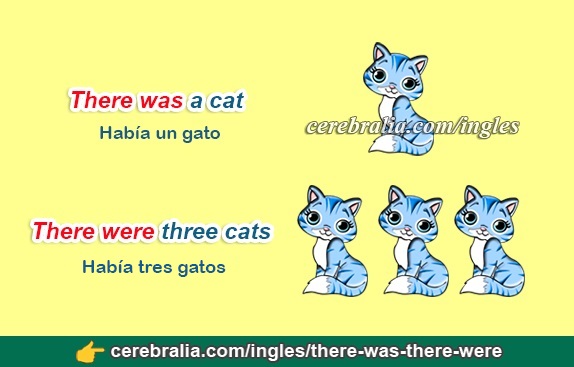Comparte en:
En español, utilizamos la palabra «hay», forma conjugada del verbo haber, para hablar sobre la existencia de objetos, cosas o personas. En el tiempo pasado decimos «había», cuya equivalencia en inglés es «there was» para el singular y «there were» para el plural.
A continuación verás en más detalle sus diferencias, su estructura gramatical en oraciones afirmativas, negativas e interrogativas y también varios ejemplos de oraciones.
There was
Había (singular)
El pasado de «hay» en inglés, para la forma singular, se forma con there seguido del verbo to be en singular was. There was, se traduce al español como «hubo» o «había». El complemento directo que le sigue está en singular, va acompañado de sustantivos contables en singular y con sustantivos incontables.
En una oración, there was, puede ir acompañado del artículo indefinido «a» o «an». También de los cuantificadores some, a little, much, a lot of.
En esta lección abarcaremos el uso de hay en inglés en el tiempo pasado. Fíjate cómo es la estructura para formar oraciones afirmativas, negativas e interrogativas con there was.
| Oraciones afirmativas | Oraciones negativas | Oraciones interrogativas |
|---|---|---|
| There was | There was not = There wasn't | Was there? |
Oraciones afirmativas:
- There was an apple on the table.
(Había una manzana en la mesa) - There was a beautiful picture in the gallery.
(Había un hermoso cuadro en la galería) - There was a lightning storm last night.
(Hubo una tormenta eléctrica anoche)
Oraciones negativas:
- There wasn't an apple on the table.
(No había una manzana en la mesa) - There wasn't an amusement park in the city.
(No había un parque de diversiones en la ciudad) - There wasn't any furniture in the apartment.
(No había ningún mueble en el apartamento)
Oraciones interrogativas:
- Was there an apple on the table?
¿Había una manzana en la mesa? - Was there any mineral water in the fridge?
¿Había agua mineral en el refrigerador? - Was there a music festival in your town?
¿Hubo un festival de música en tu ciudad?
✅ Hay varias formas de responder a las preguntas formuladas con there was. Si queremos preguntar ¿Había leche en el refrigerador? decimos: Was there any milk in the fridge?
➤ Respuesta afirmativa:
- Yes, there was.
(Sí.) - Yes, there was some milk in the fridge.
(Sí, había un poco de leche en el refrigerador)
➤ Respuesta negativa:
- No, there wasn't.
(No.) - No, there wasn't any milk in the fridge.
(No, no había leche en el refrigerador) - No, there was no milk in the fridge.
(No, no había leche en el refrigerador)

There were
Había (plural)
El pasado de «hay» en inglés, para la forma plural, se forma con there seguido del pasado del verbo to be en plural were. There were, se traduce al español como «hubo» o «había». El complemento directo que le sigue está en plural, va acompañado de sustantivos contables en plural.
En una oración, there were, puede ir acompañado de los números cardinales (uno, dos tres, cuatro, cinco, etc). También de los cuantificadores some, a few, many, a lot of.
A continuación te presentamos la estructura para formar oraciones afirmativas, negativas e interrogativas con there were.
| Oraciones afirmativas | Oraciones negativas | Oraciones interrogativas |
|---|---|---|
| There were | There were not = There weren't | Were there? |
Oraciones afirmativas:
- There were two apples on the table.
(Había dos manzanas en la mesa) - There were only ten people at the party.
(Había solo diez personas en la fiesta) - In the past, there were many trees in that park.
(En el pasado, había muchos árboles en ese parque)
Oraciones negativas:
- There weren't any tomatoes in the shop.
(No había tomates en la tienda) - There weren't many children in the school.
(No había muchos niños en la escuela) - There weren't any eggs for breakfast this morning.
(No había huevos para el desayuno esta mañana)
Oraciones interrogativas:
- Were there two dogs in the garden?
¿Había dos perros en el jardín? - Were there twenty students in the class?
¿Había veinte estudiantes en la clase? - Were there many people in the concert yesterday?
¿Había mucha gente en el concierto ayer?
✅ Hay varias formas de responder a las preguntas formuladas con there were. Si queremos preguntar ¿Había leones en el zoológico? decimos: Were there any lions in the zoo?
➤ Respuesta afirmativa:
- Yes, there were.
(Sí.) - Yes, there were some lions in the zoo.
(Sí, había algunos leones en el zoológico)
➤ Respuesta negativa:
- No, there weren't.
(No.) - No, there weren't any lions in the zoo.
(No, no había leones en el zoológico) - No, there were no lions in the zoo.
(No, no había leones en el zoológico)
🥇 Sigue aprendiendo: 🙂
✅ Habrá en inglés: THERE WILL BE
✅ Hay en inglés: THERE IS y THERE ARE
✅ ¿Cómo se usa SOME y ANY en inglés?
✅ ¿Cómo se usa A LITTLE y A FEW en inglés?
✅ Aprende a usar MUCH, MANY, A LOT OF en inglés
✅ Los sustantivos contables e incontables en inglés
✅ Canciones en inglés traducidas al español 🎵

